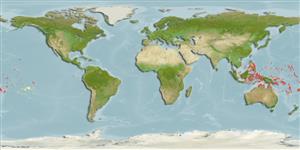>
Blenniiformes (Blennies) >
Blenniidae (Combtooth blennies) > Salariinae
Etymology: Blenniella: Diminutive of blennius, Greek,blenios = mucus (Ref. 45335).
More on author: Günther.
Environment: milieu / climate zone / depth range / distribution range
البيئة
بحري مرتبطة بالشعاب; نطاق العمق 0 - 3 m (Ref. 90102). Tropical; 16°N - 24°S
Pacific Ocean: southern Japan to the Moluccas, east to Mariana Islands, Tonga, and Tuamoto Archipelago; Tawara, Kiribati and Howland Island. Replaced by Blenniella cyanostigma in the Indian Ocean (Ref. 37816).
الحجم / وزن / العمر
Maturity: Lm ? range ? - ? cm
Max length : 8.2 cm SL ذكر/ مختلط الجنس; (Ref. 9962); 6.8 cm SL (female)
الأشواك الظهرية (المجموع) : 12 - 14; الأشعة الظهرية الناعمة (المجموع) : 19 - 22; شوكة شرجية: 2 - 3; أشعه شرجية لينه: 20 - 23; فقرات: 37 - 40. Diagnosis: Dorsal fin XII-XIV, 19-22, notched between spinous and segmented-ray portions; anal fin II-III, 20-23 (rarely 23); pectoral rays 12-15 (usually 14); pelvic fin I, 3; caudal fin procurrent rays 10-16, segmented rays 13. Vertebrae 10-12 + 26-29. Last pleural rib on 11-13th vertebrae. Orbital cirrus simple filamentous; nasal cirri short and simple to palmate with 2-7 branches; nape without cirri. Lateral line, continuous anterodorsally below dorsal spines from 6-7th to 10th, disconnected posteroventrally up to below dorsal spine 9-13th. Mandibular pores 3-7 Lips margin entire. Occipital crest present, higher in males (Ref. 9962). Body depth at anal-fin origin 5.8-7.3 in SL. Male crest yellow; body greyish, shading ventrally to white, with 9 brown or olive vertical bars on side, and some horizontal streaks on middle of body (Ref. 90102). Females have numerous longitudinal pinstripes on their sides and black specks on their fins while males have dark patches and small blue spots on their sides (Ref. 37816).
Adults inhabit exposed shallow shores (0-3 m) and often found in tidepools (Ref. 90102). Oviparous. Eggs are demersal and adhesive (Ref. 205), and are attached to the substrate via a filamentous, adhesive pad or pedestal (Ref. 94114). Larvae are planktonic, often found in shallow, coastal waters (Ref. 94114).
Life cycle and mating behavior
النضج | التكاثر | وضع البيض | بيض | الخصوبة | Larvae
Distinct pairing (Ref. 205).
Springer, V.G. and J.T. Williams, 1994. The Indo-West Pacific blenniid fish genus Istiblennius reappraised: a revision of Istiblennius, Blenniella, and Paralticus, new genus. Smithson. Contrib. Zool. 565:1-193. (Ref. 9962)
IUCN Red List Status (Ref. 130435: Version 2024-2)
استخدامات بشرية
أدوات
تقارير خاصة
Download XML
مصادر علي الأنترنت
Estimates based on models
Preferred temperature (Ref.
123201): 26.7 - 29.4, mean 28.7 °C (based on 908 cells).
Phylogenetic diversity index (Ref.
82804): PD
50 = 0.5020 [Uniqueness, from 0.5 = low to 2.0 = high].
Bayesian length-weight: a=0.00776 (0.00356 - 0.01695), b=3.00 (2.81 - 3.19), in cm total length, based on LWR estimates for this (Sub)family-body shape (Ref.
93245).
مستوى غذائي (Ref.
69278): 2.8 ±0.3 se; based on size and trophs of closest relatives
المرونه (Ref.
120179): عالي, الحد الزمني الأدني لتضاعف عدد أفراد المجتمع أقل من 15 شهر (Preliminary K or Fecundity.).
Fishing Vulnerability (Ref.
59153): Low vulnerability (10 of 100).
Nutrients (Ref.
124155): Calcium = 191 [89, 351] mg/100g; Iron = 0.902 [0.484, 1.651] mg/100g; Protein = 17.9 [16.6, 19.1] %; Omega3 = 0.0717 [, ] g/100g; Selenium = 16.5 [7.3, 39.6] μg/100g; VitaminA = 133 [31, 574] μg/100g; Zinc = 2.93 [1.85, 4.49] mg/100g (wet weight);
